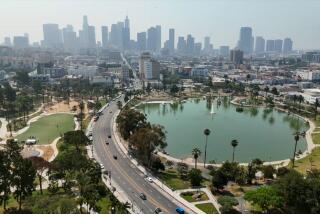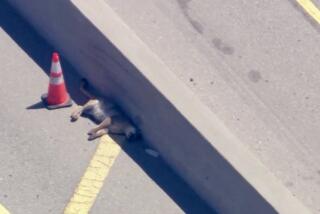Preserving bridges to the past
STRATFORD, CONN. — The narrow lanes weave through the forest, past timber guardrails, low-slung bridges with stone facades and trees whose crimson leaves glisten in the fall sun.
But take a closer look. Those log guardrails hide steel reinforcements. And some of the charming bridges have been swapped out for modern, sharp-edged models. On second thought, don’t take a closer look; you might find yourself wrapped around one of those magnificent trees.
The Merritt Parkway, known to many Americans as a speed trap for David Letterman, has coursed for 69 years through southwestern Connecticut, linking what are now some of its toniest suburbs to New York. But after being added this month to the World Monument Fund’s list of most endangered sites, the four-lane, 37.5-mile road is enjoying a newfound status -- alongside such treasures as the tombs of Egypt, France’s chateaux and Machu Picchu in Peru.
That should come as no surprise, say lovers of the Merritt and other parkways across the United States, such as the Arroyo Seco Parkway (a.k.a. the Pasadena Freeway); the George Washington Memorial Parkway that loops through Virginia, Maryland and Washington, D.C.; and the Beartooth Highway in Montana and Wyoming.
“They are as intentionally designed as the gardens of Versailles. They just happen to be roadways,” said Amy Freitag of the World Monuments Fund, which sorted through 195 nominations before settling on 93 sites for its 2010 list.
By being on the list, the Merritt will probably receive even more attention from preservationists, which could translate to more funding to protect it. Recognition of the Merritt’s aesthetic qualities also could help preservationists who are at odds with federal highway officials seeking to upgrade other parkways.
“It gives us a chance to remind people that these parkways exist all across the country. They really are a special, special thing that America produced in the 20th century,” Freitag said of the roadways, which were designed for leisurely motoring in an era when cars, and life, moved at a far slower pace.
In addition to dozens of Art Deco bridges, the Merritt is cherished for the thick woods that grow along the roadside and the trees that dot its median. Arching branches form a leafy canopy over sections of the road. Deer nibble on grass along the narrow shoulders.
The few gas stations along the Merritt have cabin-like designs. And there isn’t a McDonald’s or Starbucks in sight. (There are, however, some alarmingly short on-ramps into speeding traffic.)
“When I was a kid, we’d come down this beautiful, beautiful roadway. You’d enter it and, all of a sudden, there would be flowers growing alongside of the road and everyone in the car would be calmer,” said John B. Lindquist, 70, of Stratford. “Even my brother and I would fight less in the back seat.”
But rarely do the views of parkway preservationists mesh with those demanding adherence to modern safety guidelines -- be they in suburban Connecticut or the wilds of the West, where the Beartooth Highway travels. Where federal officials see higher guard walls as protection for drivers skirting rivers, preservationists see them as blocking views. Where federal officials see wider shoulders and lanes as safeguards against hitting trees, preservationists see them as destructive to the forest.
“Those trees might be a historic part of the roadway, but they are in an area where, by today’s standards, they should not be,” said Gloria Scott of Caltrans, which has struggled to keep the historic character of the 8.2-mile Arroyo Seco Parkway. In 2002, that stretch of the 110 Freeway was designated a National Scenic Byway to bolster preservationist efforts.
But parkways that were designed for recreational driving nowadays are used by commuters living in the suburbs. They want to get to work or home quickly -- as Letterman, who has used his nightly monologue to joke about his Merritt Parkway speeding tickets, can attest. Accidents happen, sparking demands for engineering changes.
In the 1990s, a series of fatal head-on collisions prompted calls to alter the George Washington Memorial Parkway, which meanders for 25 miles along the woodsy shoreline of the Potomac River. Federal highway officials directed that barriers be installed where the median was less than 8 feet wide. Dottie Marshall, the National Park Service’s superintendent for the memorial parkway, said that officials didn’t want glaring metal to disturb the scenery, so they opted for steel beams prefabricated to look old and rusty -- the highway equivalent of distressed jeans.
“When that guard rail was installed, for about 30 to 45 days I spent all day long on the phone taking calls from people complaining about it: that we had destroyed the character [of the road] . . . that people should change their behavior and drive slower,” Marshall said.
Nancy Savin, a member of the Merritt Parkway Conservancy, said of historic roadways that “to widen [a] highway and destroy it is not the answer.” What is needed, she said, is increased use of public transportation.
Jill Smyth, the conservancy’s executive director who wrote the 14-page nomination that put the parkway on the Monument Fund’s watch list, agreed. “It’s a strange poster child for preservation, but it goes to show there’s room for everything,” Smyth said at a recent event to support the Merritt’s preservation.
The gathering in a mall parking lot off Exit 53, near the Merritt Parkway Museum, drew scores of antique car aficionados who showed off vehicles in vogue during the parkway’s early days.
When the parkway was built, it boasted 69 bridges -- no two the same. At least three have been replaced, and several with more modern designs have been added. The Monuments Fund warned that more bridges could be affected if lanes were widened, shoulders added or other changes made. A nearly $67-million roadway safety and rehabilitation project is due to get underway before the end of the year.
“It’s not changing the footprint or the look of the bridges,” said Kevin Nursick of Connecticut’s Department of Transportation, adding that every project on the Merritt, right down to tree removal, must be vetted by preservationists. “We do everything we can to ensure the work we’re doing is sensitive to the parkway. About the only thing we don’t discuss with stakeholders is how to mow the grass.”
According to officials, most crashes on the Merritt, which Nursick said has an accident rate on par with other state thoroughfares, are caused by tailgating or speeding. Preservationists assert that many upgrades lead people to drive more quickly, because they feel more comfortable.
They also argue against the aesthetics of using modern guard walls that on some roads have replaced the original, solid stone barriers. On some parkways, what looks like a rock wall might be stone veneer covering a concrete core or concrete pressed to look like stone.
“There’s a lack of integrity to that,” said Don Bachman, an environmentalist in Bozeman, Mont., who has fought for restrictions on changes to the Beartooth Highway. “It’s kind of a duping of the public to put these things up when they’re just as modern as a new Prius.”
On the Merritt, Nursick said, the state does all it can to please preservationists. But given the area’s increased traffic, change is inevitable.
“If it was exactly the same as it was when it was built, it wouldn’t be very safe,” he said. “But given the changes that have taken place in this state, in this country, in this world, the Merritt Parkway essentially remains the same.”
--
More to Read
Sign up for The Wild
We’ll help you find the best places to hike, bike and run, as well as the perfect silent spots for meditation and yoga.
You may occasionally receive promotional content from the Los Angeles Times.







